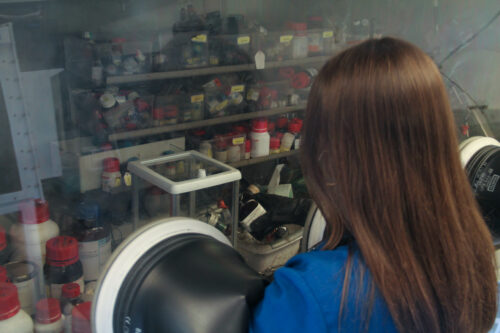Photo by Matthew Zoerb.
Since the very first use of antibiotics, researchers have known about antibiotic resistance in bacteria. However, it takes a large investment of time and resources to discover novel antibiotics, which must be made cheaply available for patients. Therefore, the pharmaceutical industry has turned away from antibiotic development due to the immense input required and limited opportunity for profit, allowing antibiotic resistance to rise and our ability to fight infections to fall.
Olivia Goethe and Mikaela DiBello, former and current graduate student researchers in Professor Seth Herzon’s lab in the Yale Department of Chemistry, tackled this issue by seeking to create new antibiotics from one core molecule, pleuromutilin. Pleuromutilin is naturally produced by fungi, and its derivatives have been used clinically as antibiotics for skin infections and community-acquired pneumonia. Herzon’s lab has also previously worked with pleuromutilins.
Their recent paper, published in Nature Chemistry, presents a new total synthesis pathway to create pleuromutilin derivatives. This pathway is an improvement upon Herzon’s previous method published in 2017, as well as pre-existing semisynthesis pathways, which rely on bacteria to synthesize products rather than commonly available chemical reagents. “Our [new] synthetic route can access [unique] chemical modifications, like changing functional groups and changing ring sizes. But through semisynthesis, you’re kind of blocked in. You can only modify the easily accessible functionality,” Goethe said. Essentially, this new pathway allows for infinite new pleuromutilin derivatives to be produced by changing, removing, and rearranging atoms in a way that other synthesis methods could not. This total synthesis pathway is a powerful tool for learning about the properties of various pleuromutilin derivatives.
Another key advancement was the ability to produce pleuromutilin derivatives in higher yields. Having enough product is vital for testing antibiotic activity. Obtaining viable yields of products was not an easy process, however. Each step in the synthesis pathway must be executed properly to give the correct molecule with the correct orientation or stereochemistry. Otherwise, subsequent reactions will result in little to no yield of product. This was one of the most challenging parts of the research process. It took Goethe months of going through the available literature and experimenting with different reactions to obtain the desired product in a reaction that initially gave the wrong stereochemistry. “I had to have the right stereochemistry in order to make a usable amount of [the pleuromutilin derivative], which is why I definitely had to fix this, or I was screwed,” Goethe said.
Out of all the pleuromutilin derivatives tested for antibiotic activity, many were surprisingly inactive, including many of the core derivatives proposed to improve metabolic stability, which would help the overall antibiotic effect. The most successful derivative contained a halogen, which was somewhat unexpected. “If you went into the ribosome site [of the bacteria], there wasn’t really any indication that including a halogen there would be helpful,” Goethe said. Successful pleuromutilin antibiotics usually bind to sites on bacterial ribosomes, but the chloride group had an unexpected effect that is worth more exploration. Work can also be done to find more compounds and, eventually, test the stability of pleuromutilin antibiotics once they enter the body. “It seems like, to me, medical chemistry is just a numbers game. You just need to make a ton of compounds and study them to get trends. There’s a lot of interest in studying pleuromutilins, and we’re contributing to the information available about what we can do to this molecule,” Goethe said. Ideally, this research will lead to the straightforward synthesis of novel, cheap, and accessible antibiotics.
Goethe found this research for her PhD to be extremely rewarding. “I think that it’s really cool, just something you made with your hands from stock materials can be used to kill bacteria,” Goethe said. Now, Goethe works at Gilead Sciences, a biopharmaceutical company. She works in process chemistry, preparing materials for clinical phase trials, which test previously experimental treatments in human participants. “I think that my ideal dream [job] would be that I’ll combine the experience that I get here [at Gilead] in drug development with the passion I had for antibiotics, and maybe once I get a couple of years of experience, I can help antibiotic companies actually start to make some more drugs,” Goethe said.

